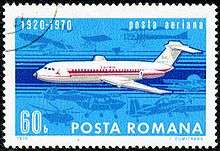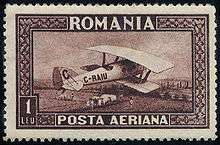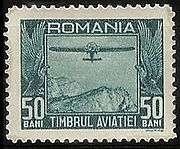Aviation in Romania
| Transport in Romania |
|---|
| Companies |
Romania has a rich tradition in aviation. At the beginning of the 20th century, pioneers such as Aurel Vlaicu, Traian Vuia and George Valentin Bibescu made important contributions to early aviation history, building revolutionary aeroplanes and contributing to the international scene.
In the present, the Romanian Civil Aeronautic Authority oversees all aviation activities.
History
Pioneers
George Valentin Bibescu was a Romanian aristocrat who became an early aviation pioneer and international figure. He flew a balloon named "Romania" brought from France 1905. Later he tried to teach himself how to fly a Voisin airplane, also brought from France, but without success. After Louis Blériot's demonstrative flights in Bucharest on October 18, 1909, Bibescu went to Paris and enrolled in Blériot's flying school where, in 1910, he obtained International Pilot License number 20. After returning from France, Bibescu organized the Cotroceni Piloting School in Bucharest where Mircea Zorileanu and Nicolae Capşa were licensed. On May 5, 1912, he founded the Romanian National Aeronautic League. Bibescu would later be instrumental in founding the Fédération Aéronautique Internationale (FAI), the international regulatory body for aeronautics. Between 1927 and 1930 he was its vice-president, and becoming president in 1930 and remaining so until 1941.
Traian Vuia was a Romanian inventor and aviation pioneer. He constructed his first powered, fixed wing aircraft with wheeled undercarriage and in 1906 he flew short hops in it at Montesson near Paris, France. On March 18 he flew about 12 metres at a height of 1 foot, and on 19 August he flew for 24 metres.[1][2][3] Although unsuccessful at true flight, Vuia's aircraft has been credited as "the first man-carrying monoplane of basically modern configuration" and influenced the more successful Brazilian pioneer Alberto Santos-Dumont.[4][5] Vuia went on to experiment with another monoplane and two helicopters but none was successful.
Aurel Vlaicu was born in Transylvania, then part of Austria-Hungary. Having constructed a glider with his brother, he moved to the Kingdom of Romania in 1909. His first aircraft, the Vlaicu I, was constructed at the Army Arsenal at Bucharest and first flown on 17 June 1910, a day still celebrated in Romania as National Aviation Day. Vlaicu later constructed two more aircraft, fatally crashing the second in 1913 before the third had flown.[6]
Henri Coandă exhibited the Coanda-1910 at the Second International Aeronautical Exhibition in Paris around October 1910, and built his first flying aircraft in 1911. Later he worked in the UK to design aircraft for World War I, a number of Bristol-Coandă and Coandă monoplanes being purchased by the Romanian Army and Government.[6] Coandă continued to research in a variety of fields. He is most famous for discovering the Coanda effect in aerodynamics and fluidics.
Early military aviation
The Romanian Army took an interest in aviation from the earliest days, facilitating the construction of the Vlaicu I in 1910. The next year the Army formed the Aviation Group, which over the next few years constructed Farman biplanes under license and also acquired two Blériot monoplanes, several Bristol-Coandă monoplanes and Two Morane Type F monoplanes. On 20 April 1913 it became the Corp al aernautlior permanenti - the Permanent Corps of Aeronauts. Three months later they engaged in reconnaissance sorties over the Bulgarian border at the start of the Second Balkan War.[6]
The Romanian Air Corps was established on 15 September 1915, at a time during the First World War when Romania was still neutral. That same year, even before Romania joined the Western Powers in 1916, it was supplied with 44 aircraft by France. During the ensuing defeat of Romanian forces, the Air Corps was chronically short of serviceable aircraft and supplies and was reorganised several times.[6]
After the World War, the Air Corps again saw action in the 1919 campaign to secure Transylvania from Hungary. By then the Air Corps was in a sorry state, but following the collapse of the Hungarian communist regime the Air Corps gained 87 captured aircraft. From then on the air arm grew steadily, changing its name in 1920 to the Aeronautica Mailtaria Romaina (Romanian Military Aviation) and in the 1930s to the Fortelor Aeriene Regal ale Romania (Royal Air Forces of Romania, or FARR). Further aircraft were acquired from France and licensed production was set up at various centres. By the early 1930s Romanian aviation had advanced enough to produce its own designs and types such as the SET 10 fighter-trainer, IAR 15 and IAR 16 began to appear. However these were not yet judged adequate and for a period front line fighter squadrons were equipped with Polish PZL fighters, examples of which were both purchased and manufactured. In the late 1930s the FARR also significantly developed its bombing capabilities and the IAR 37 light reconnaissance bomber went into production.[6]
As World War II loomed in 1939, Romania found itself in a precarious position and made many treaties with its neighbours. One result of this was a change of supplier; a number of German aircraft were procured and IAR licensed production of the Junkers Jumo 211Da aero engine. In response Britain began supplying frontline aircraft, although only a few Hawker Hurricanes arrived in the few days left before hostilities would begin.[6]
World War II
Following the outbreak of war and the German invasion of Poland, over 100 surviving aircraft of the Polish Air Force joined the FARR. However the increasing aggressiveness of the Axis powers Germany and Russia forced Romania to join them. Through 1940 and '41 the German presence and influence grew strongly.
In June 1941, with the FARR operational strength at 504 aircraft, Romania joined Germany in the attack on the Soviet Union and the FARR was committed heavily in support. In March 1942 deliveries of the IAR 80 fighter began, and both this type and its derivative the IAR 81 joined front line operations. Following a long and bloody campaign, by the summer of 1943 emphasis was beginning to switch to the air defence of Romania and especially the oil wells and refineries which supplied Germany, the FARR giving a good account of itself during the American Operation Tidal Wave bombing raids. By now the FARR was operating a great mix of aircraft types, including more than 80 types of trainer.
On 20 August 1944 the Soviets invaded Romania. Following a brief period of confusion, Romania changed sides and, once more allied with the Soviet Union, turned against its German occupiers. Although by now possessing less than 200 operational aircraft, the FARR joined in the attack on German forces. Despite chaotic conditions, exacerbated by the Soviet demand for Romanian mechanics to maintain their aircraft, IAR continued a low level of manufacture and the FARR began to rebuild its strength. But then in 1945 operations over Slovakia and against German and Hungarian forces reduced its strength once again, having just 10 operational combat squadrons remaining by the end of the war.[6]
Postwar
In 1947 Romania became a republic and its air arm changed its name to the Fortele Aeriene ale Republici Populare Romania, the Air Forces of the Romanian People's Republic or FR-RPR. From 1948 greater cooperation with Soviet forces began with the introduction of the Yakovlev Yak-11 trainer, and the ageing combat fleet progressively supplemented and replaced by more modern Soviet types.
The first jet fighter arrived in the 1950s, in the form of the Yakovlev Yak-23. A process of expansion and modernisation continued, and accelerated after Romania joined the Warsaw Pact in 1955. The supersonic age arrived during this period, with the introduction of the Mikoyan-Gurevich MiG-19. The expansion stopped after the withdrawal of the last Soviet forces in 1964, and the FR-RPR ended its participation in Warsaw Pact exercises. 1965 saw the introduction not only of the Soviet Mikoyan-Gurevich MiG-21 fighter but also the Czech Aero L-29 Delfin jet trainer.
1966 saw yet another name change accompanying Romania's establishment of a Socialist Republic, to the Fortele Aeriene ale Republici Socialistii Romania - the Air Forces of the Romanian Socialist Republic or FR-RSR. The new FR-RSR went on to maintain and modernise its fleet, including the introduction of a variety of Mil helicopters, some of them Polish-built.[6]
In the 1970s Romania began once more to develop its own military aircraft including a joint Yugoslav-Romanian attack aircraft built in Romania as the IAR-93 Vultur, and the IAR-99 Şoim trainer - the first jet of wholly Romanian design. Helicopters such as the IAR 316 and IAR 330 were built under license from Aérospatiale, and the ROMBAC 1-11 passenger aircraft under license from BAC.
Astronautics
Dumitru Prunariu is the only Romanian astronaut who participated in a space mission (Soyuz 40 - May 14, 1981).
Romanian air transport operators

- TAROM - the state-owned Romanian operator, with the hub on Henri Coandă International Airport, Iasi International Airport
- Blue Air - hub airport: Henri Coanda International Airport, Bacau Airport, Iasi International Airport
- Ion Ţiriac Air
- Alfa Air Services
Regional Air Services - Tuzla www.regional-air.ro
Former Romanian carriers:
- Romavia
- Jaro International - hub at "Aurel Vlaicu" International Airport, Bucharest
- Angel Airlines - hub airport : Bucharest "Aurel Vlaicu"
- Dac Air
- LAR Romanian Airlines
- Carpatair - the hub airport: Timişoara "Traian Vuia"
- Jetran Air
- Acvila Air
Airports in Romania
Romania has a well-developed airport infrastructure compared to other countries in Eastern Europe, but still underdeveloped compared to Western countries standards. There are 16 commercial airports in service today, most of them opened for international traffic. Four of the airports (OTP, BBU, TSR, CND) have runways of 3,100–3,500 metres (10,171–11,483 ft) in length and are capable of handling jumbo jets. Six of the airports (BCM, CRA, IAS, SBZ, SCV, SUJ) have runways of 2,400–2,700 metres (7,874–8,858 ft) in length, while the rest of them have runways of 2,000–2,200 metres (6,562–7,218 ft) in length.
In 2011, the air traffic reached 10.7 million passengers, 5.1% more than the previous year when there were 10.2 million people flying by plane.[7][8]
Manufacturing
The industrial facilities for aircraft building and maintenance are located in Bacǎu (Aerostar), Braşov (Industria Aeronautică Română), Craiova (Avioane Craiova) and Bucharest (Romaero, Turbomecanica).
Future development
Following the ascending curve of the economy growth, the air transportation in Romania experiences a favorable trend. Carpatair is the Romanian airline with the most spectacular growth; the national carrier TAROM is recovering from a difficult period at the beginning of the 2000s, 2004 being the first profitable year in the last 10 years, but with a price: the cancellation of the long-haul flights to New York, Chicago, Montreal and Beijing. In 2006 the company started a fleet update program with the acquisition of 4 new Airbus A318 airplanes. The first Romanian low-cost airline, Blue Air, is going through a development phase, while other low cost airlines are ready to start their operations.
There are many investment projects also in airport infrastructure: the upgrading of the existing airports (major rehabilitation programs for OTP, TSR, CLJ, CND, the airports with the most significant traffic growth) and the construction of three new airports in Braşov, Galaţi - Brăila (a 600,000 inhabitants urban area without airport access) and Deva - Alba Iulia (Southern Transylvania).
Currently (dec. 2006) the most advanced project is the construction of the new Braşov Airport , the construction site opening was planned for March 2007 but construction was halted. Construction restarted in April 2013. The project consists of a 1 mil. passengers/year terminal and a runway of 2,800 m long.
Cultural significance

National Aviation Day is celebrated on 17 June, the anniversary of Aurel Vlaicu's first flight.[6]
Early pioneer aircraft have appeared on postage stamps, and Vlaicu on a bank note.
|
See also
References
Notes
- ↑ Traian I. Vuia at earlyaviators.com
- ↑ "Nouveaux essais de l'Aéroplane Vuia", L'Aérophile v.14 1906, pp. 105–106, April 1906
- ↑ "L'Aéroplane à moteur de M. Vuia", L'Aérophile v.14 1906, pp. 195–196, September 1906
- ↑ Gibbs-Smith, Charles Harvard (3 April 1959)."Hops and Flights" Flight. p. 469
- ↑ Hadirca, Dan. "Traian Vuia". Century of Aviation. Romanian Academy Library. Retrieved March 18, 2012.
- 1 2 3 4 5 6 7 8 9 Green and Swanborough (1971).
- ↑ European airport passengers up 7% in 2011 to over 1.6 billion at anna.aero
- ↑ Romania: Air traffic to grow by 5 percent in 2011, up to 10.7 million passengers at aviationnews.us
Bibliography
- Green, W. and Swanborough, G. (ed.); "Oil Well Top Cover - Sixty Years of Rumanian Military Aviation", Air Enthusiast Vol.1 No.1 (June 1971) Pages 25–35, 43.
External links
- Romanian Airports Association
- Civil Aeronautical Authority
- ROMATSA - Romanian Traffic Services Administration
- Romanian Air Force
- Romanian Space Agency


